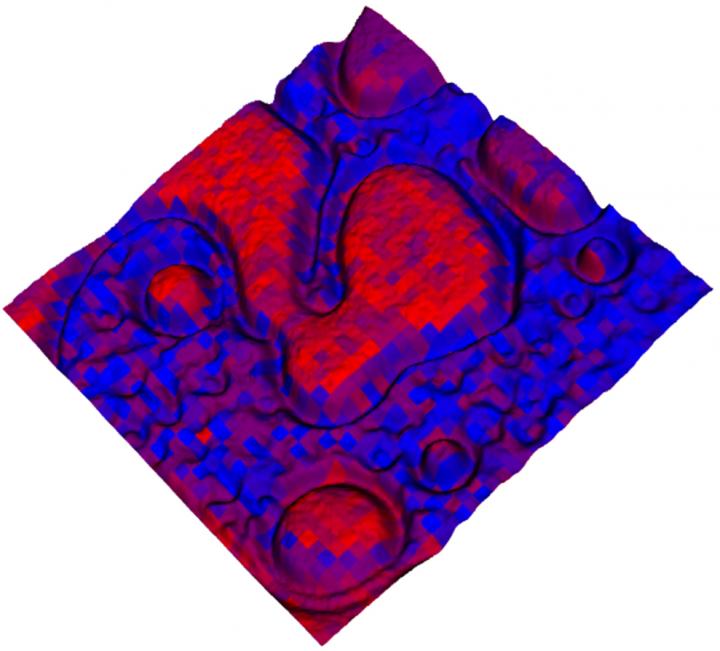New ORNL device combines power of mass spectrometry, microscopy

ORNL device is a potentially huge help for studying chemical interactions, disease, drugs. Credit: ORNL
A tool that provides world-class microscopy and spatially resolved chemical analysis shows considerable promise for advancing a number of areas of study, including chemical science, pharmaceutical development and disease progression.
The hybrid optical microscope/mass spectrometry-based imaging system developed at the Department of Energy's Oak Ridge National Laboratory operates under ambient conditions and requires no pretreatment of samples to analyze chemical compounds with sub-micron resolution. One micron is equal to about 1/100th the width of a human hair. Results of the work by postdoctoral associate Jack Cahill and Gary Van Berkel and Vilmos Kertesz of ORNL's Chemical Sciences Division are detailed in Analytical Chemistry.
“Knowing the chemical basis of material interactions that take place at interfaces is vital for designing and advancing new functional materials that are important for DOE missions such as organic photovoltaics for solar energy,” Van Berkel said. “In addition, the new tool can be used to better understand the chemical basis of important biological processes such as drug transport, disease progression and response for treatment.”
The hybrid instrument transfers tiny amounts of a material such as human tissue or an organic polymer from a sample by a laser ablation process in which material is captured and transported via liquid stream to the ionization source of the mass spectrometer. In just seconds, a computer screen displays the results.
Researchers noted that the resolution of less than one micron is essential to accurately differentiate and distinguish between polymers and sub-components of similar-sized cells.
“Today's mass spectrometry imaging techniques are not yet up to the task of reliably acquiring molecular information on a wide range of compound types,” Cahill said. “Examples include synthetic polymers used in various functional materials like light harvesting and emitting devices or biopolymers like cellulose in plants or proteins in animal tissue.”
This technology, however, provides the long-sought detailed chemical analysis through a simple interface between a hybrid optical microscope and an electrospray ionization system for mass spectrometry.
###
Funding for this research was provided by DOE's Office of Science. The National Institute of Drug Abuse-Intramural Research Program, National Institutes of Health provided the mouse brain tissue. Instruments were provided on loan through a cooperative search and development agreement by Sciex, a supplier of life science analytical platforms and licensee of ORNL technologies. The paper is available at http://pubs.
UT-Battelle manages ORNL for the DOE's Office of Science. The Office of Science is the single largest supporter of basic research in the physical sciences in the United States, and is working to address some of the most pressing challenges of our time. For more information, please visit http://science.
Image: https:/
Cutline: A hybrid 3-D optical microscope – mass spectrometry map showing optical brightness (height) and chemical distribution of poly(2vinylpyridine) (red) and poly(N-vinylcarbazole) (blue) signals of a 20 micron-by-20 micron area of a polymer blend. (ORNL/DOE)
NOTE TO EDITORS: You may read other press releases from Oak Ridge National Laboratory or learn more about the lab at http://www.
Twitter – http://twitter.
RSS Feeds – http://www.
Flickr – http://www.
YouTube – http://www.
LinkedIn – http://www.
Facebook – http://www.
Media Contact
All latest news from the category: Life Sciences and Chemistry
Articles and reports from the Life Sciences and chemistry area deal with applied and basic research into modern biology, chemistry and human medicine.
Valuable information can be found on a range of life sciences fields including bacteriology, biochemistry, bionics, bioinformatics, biophysics, biotechnology, genetics, geobotany, human biology, marine biology, microbiology, molecular biology, cellular biology, zoology, bioinorganic chemistry, microchemistry and environmental chemistry.
Newest articles

Machine learning algorithm reveals long-theorized glass phase in crystal
Scientists have found evidence of an elusive, glassy phase of matter that emerges when a crystal’s perfect internal pattern is disrupted. X-ray technology and machine learning converge to shed light…

Mapping plant functional diversity from space
HKU ecologists revolutionize ecosystem monitoring with novel field-satellite integration. An international team of researchers, led by Professor Jin WU from the School of Biological Sciences at The University of Hong…

Inverters with constant full load capability
…enable an increase in the performance of electric drives. Overheating components significantly limit the performance of drivetrains in electric vehicles. Inverters in particular are subject to a high thermal load,…





















